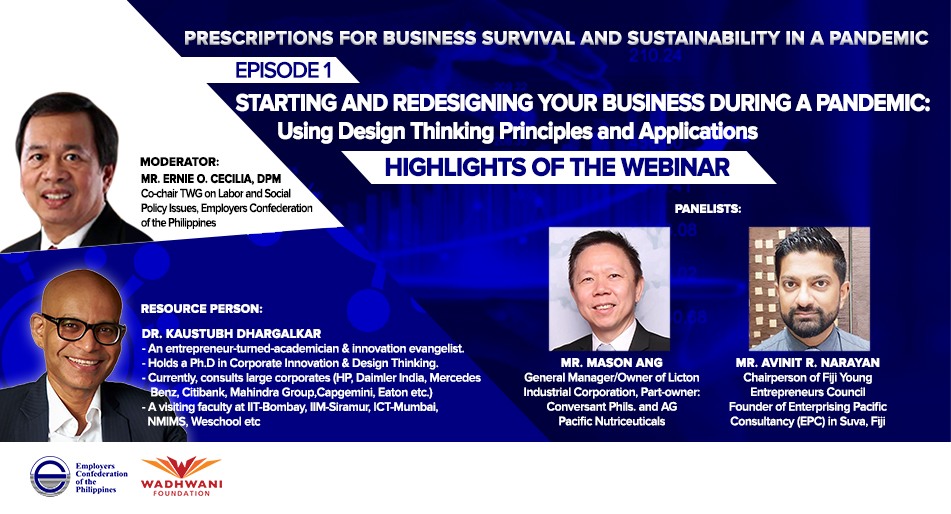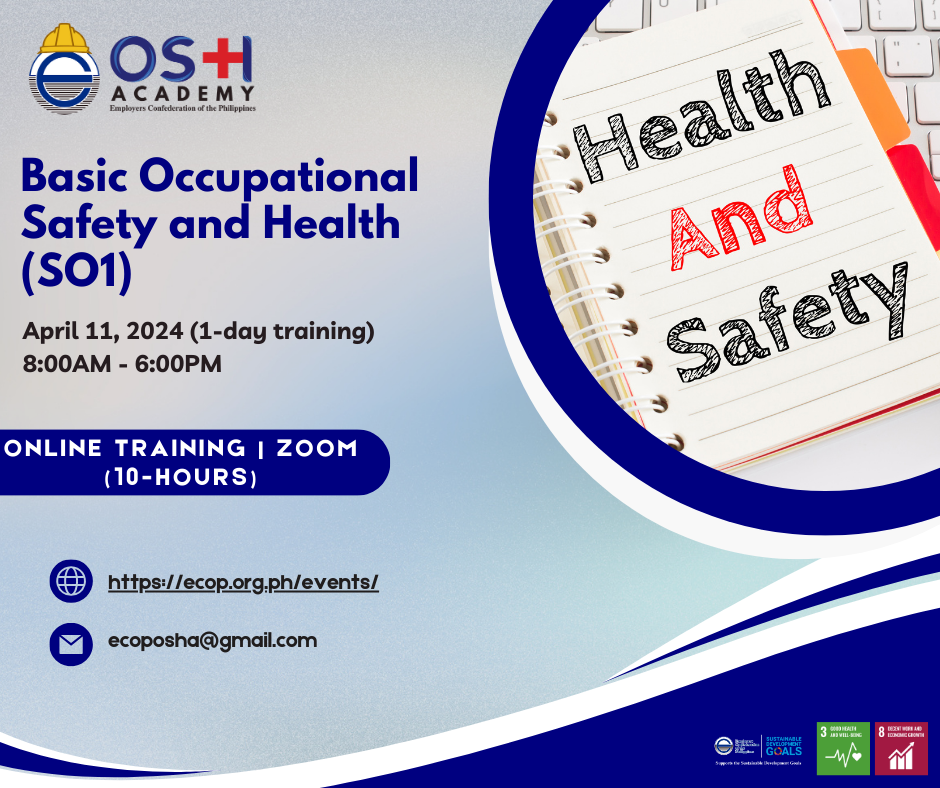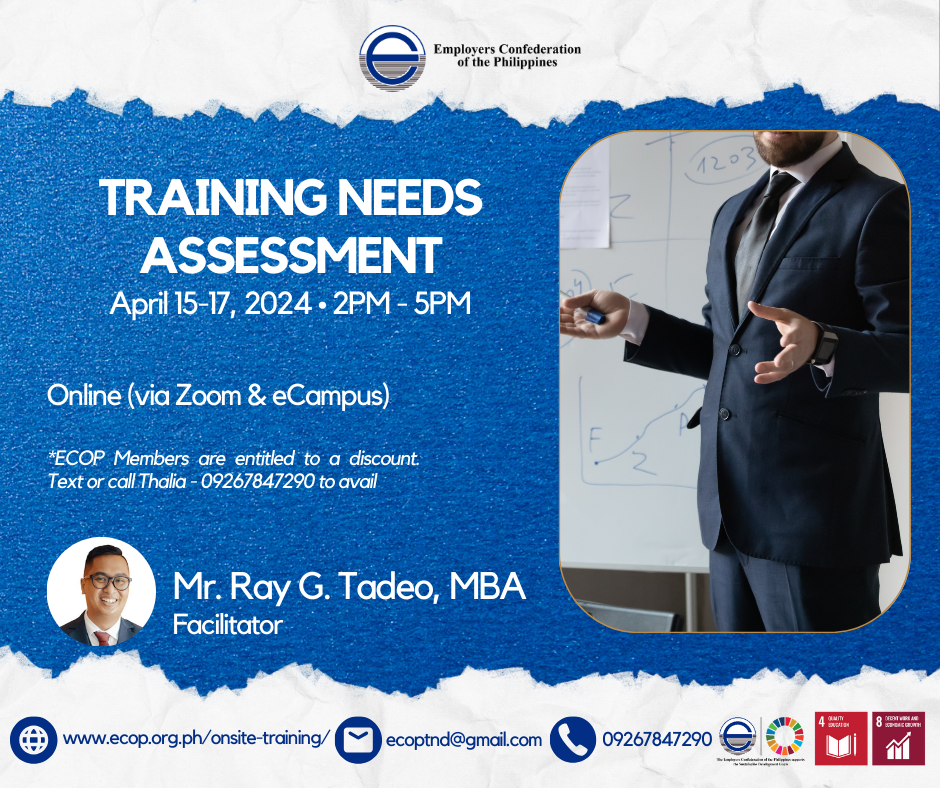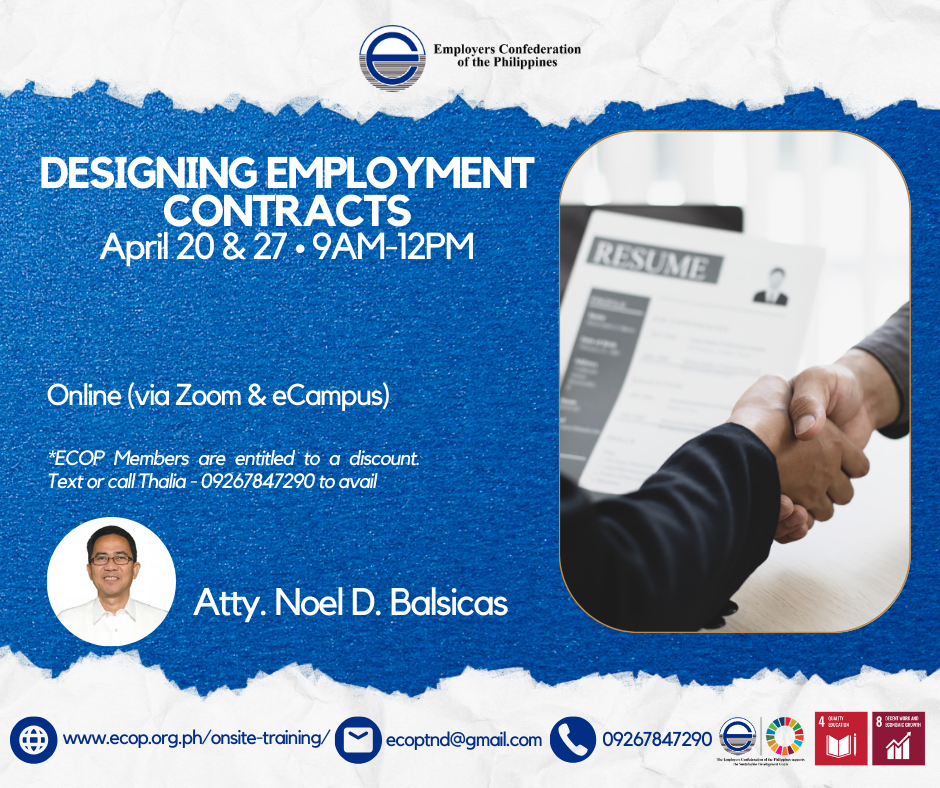Highlights of the Webinar:
Prescriptions for Business Survival and Sustainability in a Pandemic
Episode 1:
Starting and Redesigning Your Business During a Pandemic:
Using Design Thinking Principles and Applications
1 May 2020, 3:00PM – 5:00PM
Background
The Employers Confederation of the Philippines (ECOP), in partnership with the Wadhwani Foundation, launched a program called “Prescriptions for Business Survival and Sustainability in a Pandemic”. The program aims to equip start-ups and aspiring entrepreneurs with skills that will eventually help them create and develop opportunities for new business ventures especially during challenging times.
The webinar series touches on four (4) key main topics, namely: 1) Starting and Redesigning your Business during a Pandemic: Using Design Thinking Principles and Applications, 2) Building Sustainable Business Model Opportunities During Times of a Pandemic, 3) Building an “A” Team for your Enterprise: Getting the Right People to Do the Job, and 4) Getting Venture Capital for your Enterprise: Finding Capital to Start your Business.
Episode 1 talks about design thinking principles and applications. Design thinking principles direct business owners to think in such a way that they prioritize the end-user by thinking in a customer-/user-centric manner. This enhances the probability of innovation to happen because it puts the business in-touch with the end-user. It involves a process that encourages the business owner to empathize with his/her customers, troubleshoot problems, find solution to the problems on hand, look for recurring patterns, and come up with design principles that match the business’ productivity and efficiency. The essence of empathizing creates a human-centric bond between the business owner and his/her customers. The solution, on the other hand, must satisfy the following: (a) user needs, (b) business goals, and (c) technological possibilities to ensure that it is effective.
Overall, the Design Thinking Principles offer business owners with various ideas on how to improve their business plan despite experiencing crisis. It provides a good starting point for businesses, especially small and medium enterprises (SMSEs), to ascertain what seems to be uncertain during a pandemic.
SUBJECT MATTER EXPERT

- An entrepreneur-turned-academician and innovation evangelist
- Holds a Ph.D. in Corporate Innovation and Design Thinking
- Currently consults large corporates
- A visiting faculty at IIT-Bombay, IIM-Siramur, ICT-Mumbai, NMIMS, Weschool
PANELISTS

MR. MASON ANG
General Manager/Owner of Licton Industrial Corporation
Part-owner, Conversant Philippines and AG Pacific Nutriceuticals

MR. AVINIT NARAYAN
Chairperson of Fiji Young Entrepreneurs Council
Founder of Enterprising Pacific Consultancy in Suva, Fiji
MODERATOR

MR. ERNIE O. CECILIA, DPM
Co-chair, TWG on Labor and Social Policy Issues
Employers Confederation of the Philippines (ECOP)
On the Realities Business Owners Face During the COVID-19 Pandemic
To provide a situational analysis of what business owners are going through during this crisis, panelists provided an overview on their current situation and how they were able to adapt
-
- Currently, only 60% of the total business workforce is working
- Crucial factors that keep businesses alive: customers who need products, people who are willing to work, enough funds and supplies
- Customers’ demands have evolved overtime; top priority of consumers is to secure essential needs
- The issue on logistics poses as a deterrent – if a business does not have an IATF pass, it becomes difficult to move products from one place to another
-
- However, this has been resolved when the process of getting an IATF pass has been simplified
-
- Some useful strategies include: (a) saving on administration costs; (b) maintaining employees through continuous payout of salaries; (c) utilization of compatible benchmarks; and (d) have an established communication network
-
- It is important to have an established network of support. This is crucial in easing communication for sharing of practices, mobilization of people, provision of supplies, and simply helping each other cope up with the situation
-
- In a post-pandemic situation, panelists are benchmarking with others in order to know what to expect and how to facilitate recovery of their businesses
- Moreover, they also raised the concern regarding the potential challenge on the return of workers
-
- It may trigger fear that an employee might be a carrier of the virus; business owners should be able to provide solution on how to mitigate the potential problem and make their employees feel safe
-
Highlights of the Presentation:
What is Design Thinking?
-
- It is a problem-solving approach which is deeply user-centric/human-centric
- It enhances the probability of innovation to happen
- It is a process:
-
- Empathize – understand the needs of the end-user/learn from users
- Define – find patterns/design principles
- Ideate – make tangible solutions
- Prototype – synchronize solutions with the needs of the end-user
- Test – iterate to find which solution is best
-
-
- Idea of Last Mile User Connect
-
- Essential behavior for business owners to ensure relevance to the needs of customers
- Enables business owners to keep in touch with what the customers really want by investing time to hear out their customers
-
- Must satisfy three factors: (a) users’ needs; (b) business goals; (c) technological possibilities
- Idea of Last Mile User Connect
Supply → Business → Demand
-
- On the demand side, consumers are cash-strapped
-
- Employees do not have enough financial resources
- Households prioritizes buying essential needs
-
- On the supply side, producers are facing difficulties
-
- Broken supply chains
- Idle capacities of production
-
- On the demand side, consumers are cash-strapped
-
- Businesses can create a win-win scenario by accelerating the adoption of shared services model
-
- Uberization of the supply side
- Creative collaborations to utilize idle assets
- Cross-production among various sectors
- Pay as you use might become the new norm
-
- i.e. A car tire could become pay as you use
-
- Enables a cash-strapped customer to adopt to the developments
-
- Businesses can create a win-win scenario by accelerating the adoption of shared services model
Opportunities Arising Post-COVID-19
-
- During this COVID-19 control stage, we see the government acting, with the private sector and non-governmental organizations helping out
- This is an opportunity for entrepreneurs by way of creating a platform which will enable the government to have the Last Mile User Connect (execution ability)
-
- When the government learns to apply the idea of Last Mile User Connect, it will then realize that it should provide support to the private sector as well as help NGOs
-
- Non-contact testing at massive scales
-
- Installation of high-resolution cameras at public places synced with the cloud
- Wearables capable of checking new parameters
-
- The world has a shortage of 6 million nurses
-
- Produce 6 million nurses and train them
- Virtual training at massive scales
- Augmented Reality/Virtual Reality beyond plain content has to be utilized in place of traditional classroom setting
- Education companies should be able to find methods on how to accommodate such opportunity
-
Reactions from the panelists:
-
- Ideas presented are useful in reviving businesses for it presents a perspective that is more end-user inclined
- The human-centric essence of the Design Thinking Principle will help business owners in coming up with ideas regarding what products to develop and produce
-
- Come up with product ideas that customers would like
- It is always a challenge at the end of the business owners to come up with unique and sustainable products
-
- The shared services model projects a potential of creating gains for businesses while they collaborate with each other
- The ‘pay as you use’ idea may not be appropriate in the Philippine context
- Regarding the use of technology to detect the virus
-
- Smartphone concept may also be another viable alternative in the Philippine context
- However, the cost of these technological devices must be taken into consideration
- Monitoring capability of the suggested technological devices could be useful in the short-term
- High-resolution camera is important for long-term use
-
Open Forum
What are the possible business activities to temporarily diversify in which can still be connected to the current business (eg, travel agency)?
-
- Try to see the needs of the customers, other than those related to traveling. After identifying the other needs, diversify the business in order to accommodate those needs
- Because of COVID-19, people are afraid to order for delivery. One can enter into collaboration with food/grocery delivery services; this way, customers will feel more assurance because you directly keep in touch with them
Many of the manufacturers of home decors work with the United States. How do you see the buying patterns of Americans in light of the pandemic and how can the group reinvent the business? Where should the group start?
-
- Generally, people would have concerns about buying online. When the product reaches them, they may have worries if it is virus-free and whether or not it would cause harm to them. If you are into manufacturing home décor, you should shift your efforts into other investors that have demands. You should be able to diversify your network and not focus in only one mode of doing business. You should look at opportunities in utilizing your manufacturing business into something that is required in your own country
How can the hospitality industry use technology to adapt to the situation?
-
- In terms of adapting to the new system, the sector can also look into utilizing virtual reality as a way of bringing tourists to places that they want to go to
In the field of BPO which is a client-based industry, what would be the best change model to ensure that we adapt to the new normal?
-
- Build to make your technologies efficient and be able to do faster operation. Find partnerships such as tie-up with start-up businesses who are struggling in providing BPO services to their customers
Click here to watch the webinar
Join us at the episode 1 of ECOP's Prescriptions for Business Survival and Sustainability"Starting and Redesigning Your Business During a Pandemic: Using Design Thinking Principles and Applications"!This session will be conducted in a talk-show format with local and foreign resource persons and entrepreneurship experts from Wadhwani Global University who will provide the theoretical framework.
Posted by Employers Confederation of the Philippines on Thursday, 30 April 2020









